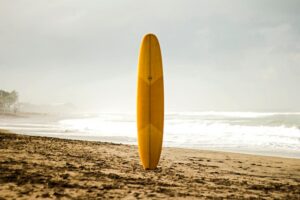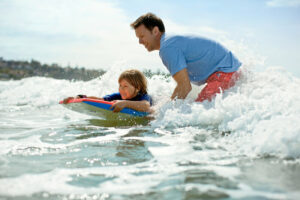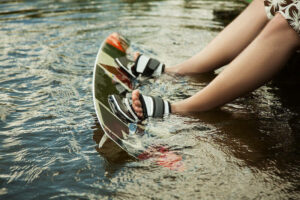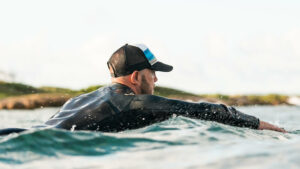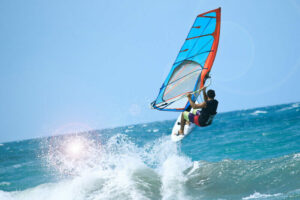Kitesurfing is not just any water sport – it is one of the most thrilling combinations of skills, boldness and knowledge. Becoming a top kitesurfer involves training your muscles to perfection, reading the elements like a master of science, a lot of patience and – not to forget – the right gear. Whether it is the board, the choice of the right wetsuit harness or the right wetsuit, to protect you from cold, harsh impacts or even jellyfish stings. With various water temperatures and conditions, the choice of wetsuit thickness, material, and design can significantly affect your kitesurfing performance.
In this article, you will get answers to the following questions:
- What type of wetsuit can you use for kite surfing?
- Do you need a special wetsuit for kitesurfing?
- What to look for in a wetsuit for kitesurfing?
- Can you wear a drysuit for kite surfing?
- What are the advantages of a drysuit over a wetsuit when kite surfing?
Choosing the Right Type of Suit
Selecting the best wetsuit for kitesurfing is crucial due to the sport’s unique demands, which differentiate it from other water activities. Kitesurfing combines the elements of wind and water, requiring a suit that effectively shields against cold water temperatures while also offering protection from the wind. This dual function is essential for maintaining comfort and performance during your sessions.
The wetsuit you choose must also prioritize flexibility. Unlike static water sports like surfing or diving, kitesurfing involves dynamic and varied movements, such as sharp turns, jumps, and rapid shifts in direction. Therefore, a wetsuit that allows full freedom of movement is vital. Flexibility in the arms, shoulders, and legs ensures that you can manoeuvre efficiently and perform advanced tricks without feeling restricted.
Additionally, the nature of kitesurfing means that you will frequently enter and exit the water. This constant immersion requires a wetsuit that dries quickly and is built for durability to withstand extended sessions. High-quality wetsuits are designed to minimize water absorption and facilitate rapid drying, which contributes to overall comfort and prevents you from feeling chilled after getting out of the water.
Attention!
Having a solid wetsuit maintenance routine for washing and drying your wetsuit properly will not cost you more than 5 extra minutes. Yet, it has the power to multiply the lifespan of your wetsuit as well as your comfort when wearing it.Abrasion resistance is another important factor. The sport can lead to frequent contact with the board or harness, making it essential for your wetsuit to endure regular wear and tear. A well-constructed wetsuit with reinforced panels in high-wear areas will help maintain its integrity and performance over time, ensuring that you get the most out of your investment.
What to Look for in a Wetsuit for Kitesurfing – 8 Key Features
Choosing the right wetsuit for kitesurfing is crucial for comfort, performance, and safety. A good wetsuit should not only keep you warm but also offer flexibility, durability, and protection against the elements. Keep an eye on those following 8 key features when looking for the best wetsuit for kitesurfing, and you will be able to feel the difference.
1. Thickness and Warmth
The thickness of a wetsuit plays a crucial role in keeping you warm in varying water temperatures. Wetsuits typically come in different thicknesses, such as 5/4mm or 3/2mm. The first number indicates the thickness around your torso, which is vital for retaining body heat, while the second number refers to the thickness in the arms and legs for flexibility.
In colder climates or seasons, a thicker wetsuit like 5/4mm or 6/5mm is recommended to protect against wind and cold water. In contrast, in warmer waters, a thinner wetsuit such as 3/2mm or even 2mm will provide enough warmth without overheating you, all while maintaining maximum flexibility.
2. Flexibility
Kitesurfing demands a wetsuit that offers high flexibility, especially for the upper body. You’ll need to perform rapid movements with your arms, shoulders, and legs while steering the kite and controlling your board.
A wetsuit made from stretchy, lightweight neoprene ensures that your movements aren’t restricted, allowing for better control and endurance during your session. Look for wetsuits labelled with “super stretch” or “ultra-stretch” materials, as these offer the most flexibility, allowing you to perform tricks and manoeuvres without the wetsuit feeling tight or uncomfortable.
3. Seams and Stitching
The seams and stitching of a wetsuit directly affect its durability and insulation properties. There are different types of seams, and the one you choose should depend on the water temperature.
→ Flat lock seams are typically found in wetsuits designed for warmer waters, but they can let in some water, reducing their effectiveness in cold conditions.
→ Glued and blind-stitched seams, however, are sealed to prevent water from entering, making them ideal for cold water kitesurfing.
→ Some higher-end wetsuits also feature taped seams, where the seams are reinforced with an internal layer for extra durability and maximum water resistance. This keeps the heat in and cold out, even in extreme conditions.
4. Fit and Comfort
Finding the right fit for your wetsuit is essential for both warmth and comfort. A wetsuit should fit snugly against your body to prevent cold water from flushing in, but not so tight that it limits your movements or causes discomfort.
The best wetsuit for kitesurfing should mould to your body, especially around key areas like the neck, wrists, and ankles, where a good seal is critical to keep cold water out. If it’s too loose, the wetsuit won’t provide proper insulation.
Always try on a wetsuit before purchasing to ensure it fits correctly while giving you freedom of movement. Remember, a well-fitted wetsuit will keep you in the water longer, as you’ll stay warmer and be more comfortable.
5. Entry System
Getting into a wetsuit can become quite the warm-up session. If you want to make breaking into your wetsuit easier, the entry system of your wetsuit can influence both its warmth and how easy it is to put on and take off.
→ Back zip wetsuits are the most common and are easy to get into but can sometimes let water through the zip, which can make you feel colder.
→ Chest zip wetsuits provide better insulation since the zip is located higher up on the chest, reducing water entry. These suits can feel a bit trickier to put on, but they offer a more watertight seal.
→ Zipperless wetsuits are becoming increasingly popular for their ultimate flexibility and water resistance, though they can be challenging to get in and out of.
Attention!
You want to make getting into your wetsuit even easier? Read more about wetsuit lubrication in our comprehensive guide!6. Durability and Abrasion Resistance
Kitesurfing can put your wetsuit through a lot of wear and tear, especially in areas where the harness rubs against your body or where your knees and elbows are constantly in contact with the board.
If you want to enjoy your chosen best wetsuit for kitesurfing for as long as possible, opt for a wetsuit with reinforced knee pads and extra durable neoprene in high-friction areas. Look for a wetsuit with abrasion-resistant panels to ensure it lasts for many sessions.
A good-quality, durable wetsuit will stand up to repeated use and harsh conditions, saving you from the financial burden of having to replace it frequently.
7. Wind Resistance
Since kitesurfing exposes you to both wind and water, wind resistance is a key feature to consider. Some wetsuits come with windproof panels, especially on the chest and back, where you’re most exposed.
These panels are designed to block out wind chill and prevent cold air from penetrating the suit. In colder or windier conditions, this feature can make a huge difference, helping you retain warmth and stay comfortable for longer periods on the water.
8. Additional Features
When choosing the best wetsuit for kitesurfing, it’s worth considering a few extra features that could enhance your experience. Hooded wetsuits for example can offer extra protection for your head and neck in cold water or windy conditions, while sealed cuffs and ankles can keep water from flushing into the suit.
Quick-dry technology is another excellent feature if you’re going to be in and out of the water, allowing your wetsuit to dry faster between sessions. Look for wetsuits with drainage holes to allow any water that does get in to escape easily, preventing pooling and discomfort.
Can You Wear a Drysuit for Kitesurfing?
Yes, wearing a drysuit for kitesurfing is an option, especially if you’re kitesurfing or swimming in extremely cold water or during the winter months. Drysuits are designed to keep you entirely dry by creating a watertight seal around your body. Unlike wetsuits, which allow a thin layer of water to enter and then warm it using your body heat, drysuits prevent any water from getting in, which can make them better suited for freezing conditions.
Why Use a Drysuit for Kitesurfing?
The primary advantage of a drysuit is warmth. Since it prevents water from entering, you stay dry, and this allows for wearing extra layers underneath for insulation. In very cold waters or harsh winter winds, a wetsuit might not provide enough warmth, while a drysuit, combined with thermal clothing, can keep you comfortable for longer sessions.
Drysuits are made of durable, waterproof materials like neoprene or latex, with tight seals at the neck, wrists, and ankles to block water. This protection allows you to stay out in freezing temperatures without worrying about the cold water seeping in.
Downsides of a Drysuit
While drysuits are excellent for warmth, they come with some downsides, particularly when it comes to flexibility. Since kitesurfing is a sport that requires a lot of movement, the extra bulk and stiffness of a drysuit can make tricks, jumps, and manoeuvres more challenging. Drysuits don’t have the snug, form-fitting design that a wetsuit offers, which can limit your range of motion and make it feel less natural during active sessions.
Another consideration is air trapping. Drysuits trap air between your body and the suit, which can create buoyancy. While this is great for keeping you afloat, it can make swimming in the water a bit more cumbersome. You also need to carefully manage the amount of air inside the suit, as too much air can make controlling your body in the water tricky.
Drysuit vs. Wetsuit for Kitesurfing
For most kitesurfers, a wetsuit is the go-to choice due to its flexibility, comfort, and the ability to provide adequate warmth in most conditions. Wetsuits are made of stretchy neoprene that moves with your body, allowing for full freedom of movement, which is essential for the dynamic nature of kitesurfing.
However, in colder climates or extreme winter conditions where water temperatures drop significantly, a drysuit can be a lifesaver. In these conditions, even thick wetsuits might not be enough to keep you warm, especially during long sessions on the water.
While wetsuits remain the top choice for many kitesurfers due to their flexibility and comfort, drysuits are a great option when you need extra warmth in cold waters. The decision between a drysuit and wetsuit ultimately depends on the water temperature, your skill level, and how much flexibility you need. For those pushing the limits in icy conditions, a drysuit is the better option to ensure you stay warm and dry.
Conclusion: How to Find the Best Wetsuit for Kitesurfing
Finding the best wetsuit for kitesurfing is all about balancing warmth, flexibility, and comfort. The right wetsuit should allow you to move freely while keeping you protected from the elements. Whether you’re a beginner and just learning the basics of how to kite surf or a seasoned kitesurfer, investing in a quality wetsuit tailored to your specific needs – considering water temperature, fit, and durability – will always enhance your overall experience. With the best wetsuit for kitesurfing, you’ll be able to focus on the thrill of the ride, confident that you’re well-equipped for any adventure on the water or in the air.
FAQ – most asked questions:
When choosing a wetsuit for kitesurfing, consider factors such as thickness, flexibility, fit, material, and water temperature. Ensure the suit provides warmth while allowing freedom of movement.
The thickness of your wetsuit depends on the water temperature you’ll be kitesurfing in. For warmer waters, a 2/2mm or 3/2mm wetsuit is typically sufficient, while colder waters may require a 4/3mm or even 5/4mm wetsuit.
Neoprene is the most common material used in kitesurfing wetsuits. Look for high-quality neoprene that offers excellent insulation, durability, and flexibility. Some wetsuits also feature additional materials like thermal linings for extra warmth.
Yes, you can use a drysuit for kitesurfing, especially in extremely cold conditions. Drysuits provide superior insulation by keeping you completely dry. However, they can be less flexible than wetsuits, which may affect your manoeuvrability.
Replace your wetsuit when it shows signs of wear such as significant tears, loss of elasticity, or compromised insulation. If it no longer fits well or affects your performance, it may be time for a new one.
The lining of a wetsuit plays a crucial role in insulation and comfort. Thermal linings help retain body heat and improve warmth, while soft linings enhance comfort and reduce chafing. A well-designed lining can make a significant difference in your overall kitesurfing experience.




